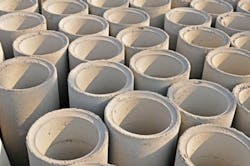About the author: Irina Garbar is associate project engineer for UL LLC. Garbar can be reached at [email protected].
If you manage construction projects for water supply infrastructure, you may be aware that a majority of states have legislation, regulations or policies requiring compliance or certification of materials and components in contact with potable water to NSF/ANSI Standard 61: Drinking Water System Components – Health Effects. In California, most projects that involve construction of new or modification of existing drinking water supply systems need to address conformance with the state’s Title 22 Drinking Water Standard Section 64591.
Under Section 64591, concrete materials and constituents (cement, admixtures, aggregates, etc.) used in the construction of wells, potable water storage tanks, water main and water distribution pipe must be compliant with NSF/ANSI 61 requirements. California adopted this standard into its Waterworks Standards, which became effective in March 2008. In May 2015, the American Water Works Assn.’s California-Nevada Section’s Water Treatment Committee issued guidelines to project owners using concrete materials for drinking water systems on how to demonstrate compliance to California Code of Regulations Title 22 Section 64591.
NSF/ANSI 61 establishes minimum health effects requirements for chemical contaminants and impurities that may be indirectly imparted to drinking water from products, components and materials used in drinking water systems. The standard includes criteria for testing and evaluation of products to ensure they do not leach harmful contaminants into drinking water. These contaminants include those regulated by the U.S. Environmental Protection Agency and Health Canada, as well as any non-regulated compounds that may be of concern.
Addressing California Concrete Compliance
Scenario No. 1: All components of the concrete mixture are NSF/ANSI 61 certified, with the exception of aggregate. Fine and coarse aggregate (sand and rocks) account for approximately 60% to 75% of the volume of concrete, but aggregate sources often are not certified. Aggregate is tested to NSF/ANSI 61 by conducting extraction (soak) testing of the materials. They are rinsed (conditioned) and exposed to pH 5, pH 8 and pH 10 water prepared in accordance with the standard for five days. The water from extraction testing then is analyzed for a variety of regulated metallic contaminants, including arsenic, chromium, copper, lead, mercury and nickel, and radionuclides. The levels of contaminants detected in water are compared to pass/fail criteria set by the standard. Mineralogy and chemical content of aggregate varies from quarry to quarry and, therefore, testing is site dependent. Evaluation of aggregate can be performed on a mixture of fine and coarse aggregate or on the smallest size aggregate, which would have the highest particle surface area per volume of exposure water and represent the worst-case test specimen.
Scenario No. 2: One or more of the individual components used for the production of potable water concrete structures is not certified to NSF/ANSI 61 or ready-mix concrete from an uncertified source is used. If more than one of the individual concrete components (admixtures, aggregate, binders/sealers, cement, etc.) used at the construction site is not certified, the Concrete Site Mix Evaluation Method can be used. Concrete test cylinders, prepared from the concrete mix in accordance with ASTM C 31 or C 192 and moist cured, can be submitted for evaluation along with detailed information on the composition of the concrete mix design for the specific installation, including the specific sources of cement, aggregate, admixtures and any other additives. At a minimum, the exposure water will be analyzed for regulated metals, radionuclides, semi-volatile organic compounds, dioxins, furans, glycols and ethanolamines.
Scenario No. 3: The ready-mix concrete producer is certified to NSF/ANSI 61 through an accredited third-party certification agency, such as UL or NSF Intl. This method enables the certified facility to supply an approved ready-mixed concrete that consists of fine and coarse aggregate, Portland cement, binders, admixtures and water for any project related to potable water for as long as it is able to maintain its certification. Throughout certification, the certified facility will be subjected to regular inspections and sample collections to ensure ongoing compliance with the requirements of the standard.
Scenario No. 4: One or more of the individual components used specifically for the production of concrete water pipe is not certified to NSF/ANSI 61. As with all concrete, the basic materials used in the production of concrete pipe are cement, aggregate, admixtures and binders/sealers. If one or more of these materials is not certified, concrete test cylinders for the evaluation of precast concrete pipe can be submitted for testing along with specific information on the composition of the concrete mix design. The exposure water is analyzed for regulated metallic contaminants.
Download: Here
